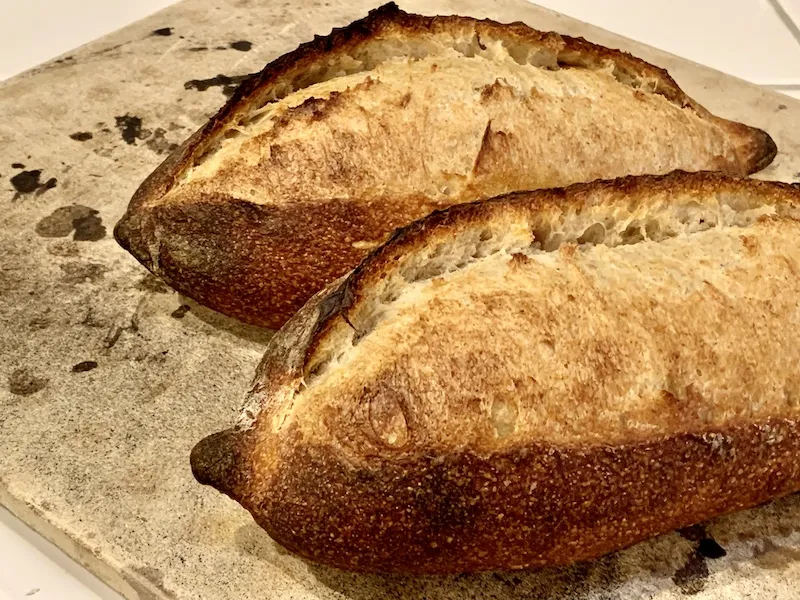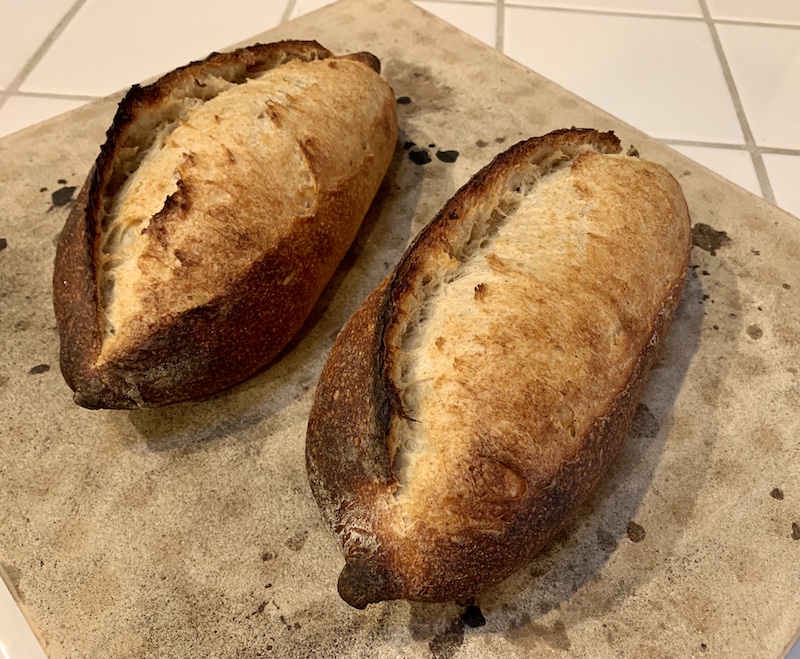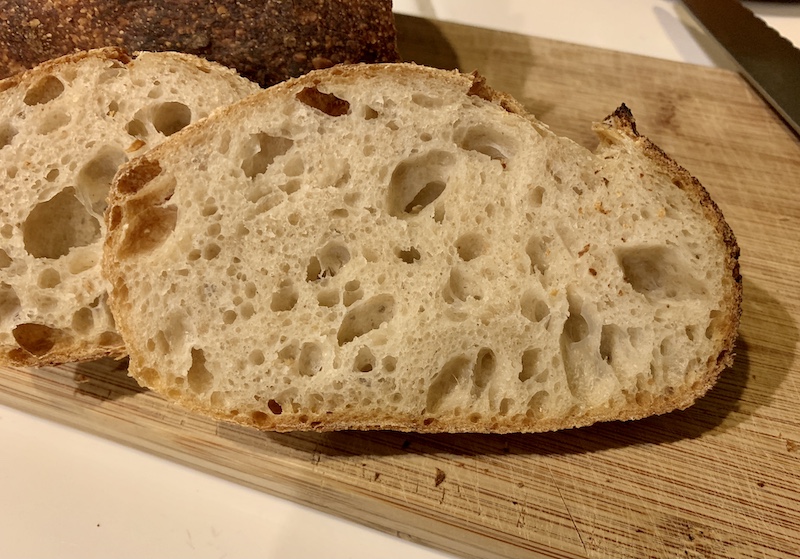
My San Joaquin Sourdough originated in Anis Bouabsa's baguettes which had won the prize for the best baguette in Paris in 2008. Bouabsa's baguettes departed from convention in utilizing a 21 hour retardation after bulk fermentation and before dividing and shaping. Jennifer Stewart (Janedo on TFL) and I initially modified Bouabsa's formula by adding a bit of rye flour and some sourdough starter for flavor. I then omitted the commercial yeast altogether and began using the modified formula to shape as bâtards. Over time, I have tweaked the formula and method in various ways, but have settled on the current one as providing the best product.
I have used this dough and method for many breads - baguettes, demi-baguettes, ficelles, pain rustique, boules and even for pizza crust. It is quite versatile and always has a delicious flavor. Of course, the baking times and temperatures require appropriate adjustment for each size and shape of loaf.
I have been gratified by the popularity of my San Joaquin Sourdough bread. It has been baked and enjoyed on every continent except Antarctica, at least as far as I know. Based on TFL posts, it seems that the SJSD has been most enjoyed as baguettes. Over the years, I have baked it in many forms, but the original shape was a bâtard of about 490gms.
I baked a couple San Joaquin Sourdough bâtards today. One went to an appreciative (and appreciated) neighbor.
Total ingredients | Wt (g) | Bakers % |
AP Flour | 479 | 89 |
WW Flour | 33 | 6 |
Medium rye Flour | 29 | 5 |
Water | 392 | 72 |
Salt | 10 | 1.8 |
Liquid starter | 17 | 3 |
Total | 960 | 176.8 |
9.2% of the flour is pre-fermented
Liquid Levain ingredients | Wt (g) | Bakers % |
AP Flour | 29 | 70 |
WW Flour | 8 | 20 |
Medium rye Flour | 4 | 10 |
Water | 42 | 100 |
Liquid starter | 17 | 40 |
Total | 100 | 240 |
Final dough ingredients | Wt (g) |
AP Flour | 450 |
WW Flour | 25 |
Medium rye Flour | 25 |
Water | 350 |
Salt | 10 |
Liquid levain | 100 |
Total | 960 |
Method
- Mix the levain by dissolving the liquid starter in the water, then add the flours and mix well. Ferment at room temperature, covered tightly, until the surface is bubbly and wrinkled. (8-12 hours)
- Dissolve the levain in the water, add the flours and mix to a shaggy mass. Cover and autolyse for 30 minutes.
- Add the salt and mix to incorporate.
- Transfer to a clean, lightly oiled bowl and cover tightly.
- Bulk ferment for 3-4 hours with stretch and folds in the bowl every 30 minutes for the first 2 hours, then a stretch and fold on the board after 2.5 hours. The dough should have expanded by about 50% and be full of small bubbles.
- Refrigerate the dough for 18-24 hours.
- Take the dough out of the refrigerator and transfer it to a lightly floured board.
- Divide the dough into 4 equal pieces for demi-baguettes or into two equal pieces fro bâtards, and pre-shape as logs or round.
- Cover the pieces and allow them to rest for 60 minutes.
- Shape as baguettes or bâtards and proof for 45 minutes, covered.
- Pre-heat the oven to 500ºF with a baking stone and steaming apparatus in place.
- Transfer the loaves to your peel.
- For baguesttes, turn down the oven to 480ºF. For bâtards, turn down the oven toe 460ºF. Score the loaves and load them onto your baking stone.
- Bake with steam for 10 minutes, then remove your steaming apparatus and continue to bake for another 10-12 minutes for baguettes or 20 minutes for bâtards.
- Remove the loaves to a cooling rack, and cool for at least 30 minutes before serving.


Enjoy!
David
- dmsnyder's Blog
- Log in or register to post comments
They look amazing and very consistent with your other bakes of this famous formula. Would you mind posting the link to the very latest adaptation of this formula? Wishing you joy and peace. Thank you.
Thanks!
Funny you should ask. I've been fretting about there being multiple postings over the past 12 years or so with differing versions. In fact, I settled on a best version about 7 years ago. It's posted in the SJSD Baguette blog entry, but it bears refreshing. I will edit the OP to include an updated version.
Thanks for asking!
Happy baking in a healthy, prosperous 2021!
David
Wonderful batards David, thanks for posting your updated formula, I wonder which it was that I used when I made baguettes with it during the summer. I’ll have to compared to the one you just posted.
Happy Holidays and a healthy new year to you and yours.
Benny
Like Benny, I too made these, I think during the community bake. At the time they were my best yet baguettes! I need to get more organized. My first task is to purge my hard drive of multiple formulas, from multiple bake attempts of all kinds of loaves of bread. I will be making these again soon.
After I graduated from Janedo/dmsnyder version of the Bouabsa to levain based bread, this was perhaps the first to hook me*. Eventually, I drifted into my own takes and variations. As I believe we should at the very least occasionally do with our own versions of a formula. But the SJSD established my baseline for just about everything that succeeded it.
Of course it isn't just the formula that makes a great bread, although that ain't a bad place to start. The skills of the baker are the other main component. And it goes without saying, although I will, these are skillfully made and beautiful.
Alan
*well, maybe the levain Gosselin came before it. Maybe...
I spent a few minutes formatting the San Joaquin Sourdough formula to the format I find easy to follow. I am posting the PNG file in case anyone likes it. No changes to your work, word for word. I will be making these again soon.
Gratitude! I have been making a batch of SJ SD Bread à la David Snyder once a week since Halloween day 2020. Has become a favorite recipe. Sometimes double or triple the quantities, but always a fav. Have always made baguettes, but am now inspired to try as Bâtards!
Thanks so much for posting this... Very appreciative of how generous you are with your time and expertise! I'm finally going to try this formula and I have one question for planning purposes: after the four stretch-and-folds in the bowl, do you typically wait another 30 minutes before the final stretch-and-fold on the board, or is it 2.5 hours after the final bowl stretch-and-fold? I know I should watch the dough and not the clock (excellent advice!), but I'm trying to figure out the ideal schedule. Thanks!
Most often, after the salt is added and I mix it in using the Tartine/Forkish method, I do S&F in the bowl at 30 and 60 minutes. Then I do a S&F on the board after another 50-60 minutes. Then I bulk ferment until the dough is well aerated and expanded by about 50%.
A lot depends on the dough strength though. If the gluten is less well developed, I may do one or two more S&F's.
My S&F on the board is what has been called a "lamination" fold. Note that some purists object to that label. Basically, I stretch out the dough as far as it will go without tearing, then do a letter fold.
Happy baking!
David
That's very helpful... Thanks so much!
Hi David,
It's been a few years since I tried this formula, but now that I'm baking a lot more I am resurrecting it. I got to wondering, since you mentioned you've baked it in a lot of forms, if you have ever used the dough to make english muffins. Thinking of how well the Tartine formula converts over to them I thought this one might fall into that camp as well. I'm still a day out, so appreciate any advice, as I may just use half the mix for muffins! Thanks.
I have never made English muffins at all. If you make them with SFSD dough, please let us know your procedure and how it worked for you. I'm intrigued.
Happy baking!
David
Ok I did go ahead with it. I eyeballed half the dough, stretched to a even thickness and cut out muffins with a biscut cutter. I cooked on a hot cast iron pan until browned on both sides, and since they were fairly thick, finished in a 300 degree oven for a few minutes. We enjoyed one last night for dinner. Photos of the muffin lineup, crumb and the other SJSD loaf. Thanks, this formula never disappoints.